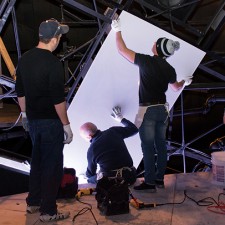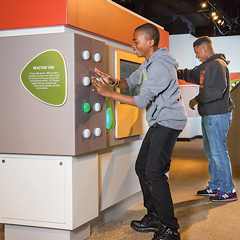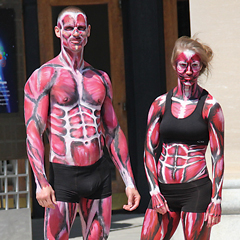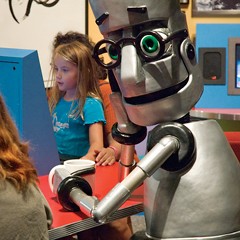Nancy Thomas of Richmond will never forget the look on her 3-year-old daughter’s face when she saw the IMAX version of Disney’s Beauty and the Beast at the Science Museum of Virginia back in 2001. “The animation seemed to come alive all around us and the sound filled the room, too. Her eyes were huge, and even at three, she sat perfectly still the whole time,” Thomas says.

She thought the experience would worry Sidney, but instead the youngster was enthralled with the movie. “The next time we went to a regular movie, she was really disappointed,” Thomas says. “She expected the same experience. As a teen, she still enjoys a good IMAX movie.”
Starting this month, films in the dome will offer an even more explosive 3D experience thanks to the museum’s new state-of-the-art digital dome projection system Digistar 5. The system’s five projectors – three in the back and two in the front – and high-resolution screen will offer clearer and brighter images.
The renovation took place over the winter months. Dismantling the old screen and cutting the panels for the new was a “very delicate operation,” says Justin Bartel, immersive experience specialist for the museum. The work was done by an England-based crew in conjunction with Evans & Sutherland, a Utah company renowned for its innovation in computer graphics. The new configuration of panels eliminates any ripples or distortions caused by seams, so images appear more fluid.

“[We’re] inviting everyone to explore the universe with us in a truly spectacular fashion,” says Richard Conti, CEO and chief wonder officer at the Museum.
The enhancements to the dome are one indication of the metamorphoses the museum has undergone since its grand opening in 1977 in the historic Broad Street Station.
Back in 1917 when travelers gathered at the train station, they never would have imagined the massive lobby where they said goodbye to loved ones as they headed to the trains would become a center for science and exploration. But, the closing of the station in 1975 made way for a different type of travel – an expedition into the world of science.
The strategy in force at the museum focuses on presenting interactive exhibits and programs that not only capture, but also sustain our interest in science and technology. “We must, like the technology that surrounds us, constantly reinvent ourselves,” says Conti, adding that the goal is to inspire people of all ages to enrich their lives through science. “What better way to do that than create larger-than-life experiences that immerse our guests in science and enable them to explore their world?”

With its focus on science and technology, the facility is an important proponent of the state’s STEM (Science, Technology, Engineering and Mathematics) initiative. It hosts the Virginia STEM Center, a resource and reference point for the initiative. “The Center will focus on the STEM pipeline and how that [plays] into workforce development,” says Chuck English, director of playful learning and inquiry. “In some ways, everything we do is related to STEM.”
Margaret Stavnos of Midlothian who often brings her teens, 13-year-old Andrew and 15-year-old Xenia to the Museum likes having that connection to science, math, technology and engineering. “Both my husband and I have science degrees [chemistry and electrical engineering] so we may be biased in regards to museums, but the Science Museum is definitely a favorite,” she says.
Exhibits such as Boost!, which opened last June, help people see where all four sciences blend together. “We try to tie more and more in with math and statistics,” English says, adding that both traveling and permanent exhibits have some type of educational component. “For permanent exhibits, we have a team that works together to create that.”

When students visit the Museum, teachers use the educational materials to prepare children for the exhibit they will be seeing. There are also educational components for lifelong learners of any age. “We work hard to make sure there is something for the family,” English says.
The Science Museum of Virginia’s current transformation revolves around its $60 million “Inspire the World” campaign, which is more than halfway to its fundraising goal. The campaign is transforming Virginia’s flagship for STEM learning by investing in the development of major new exhibition galleries. Funds raised by the campaign will also be used to develop visitor experiences, as well as improve the facilities, and expand the Museum’s outreach to the community.
The permanent Boost! exhibit, which was immediately embraced by guests, was the first major statement in the museum’s transformation. The exhibit is presented by Health Diagnostic Laboratory, Inc., a leader in health management.
Boost! visitors are invited to rev up their creativity, flexibility, memory, and strength. The one-of-a-kind permanent exhibit features cutting-edge design and technology, providing an opportunity to follow your progress over time. “It shares important scientific knowledge while giving you a chance to challenge yourself in engaging physical and mental activities,” Conti says.
Stavnos and her family list Boost! As one of their favorite exhibits because it has “so many ways to engage the mind and body,” Stavnos says. “We really love the contrast in the exhibit of high-tech interactive devices and the old-fashioned physical challenges.”
Over the past few years, the Museum has produced several exhibits that have brought people in by the droves. Body Worlds & The Brain, the most successful visiting exhibition in the Museum’s history, included more than one hundred fifty authentic human specimens preserved through a revolutionary method of preservation called plastination.
More than 100,000 people visited Richmond to see the exhibit that had previously been on display in major markets like Chicago, Houston, and Los Angeles, and almost every weekend was sold out during the summer of 2012. “Visitation represented a 60 percent increase over the last blockbuster, Titanic Science,” says Terri Rose, the Museum’s director of communications and curiosity. “Through a partnership with the Virginia Department of Health, the Museum gave away five hundred bike helmets during a series of events connected to Body Worlds that focused on safety and injury prevention.”

Other popular, temporary exhibits included Guitar: the Instrument that Rocked the World – a hit with music lovers – and Robots + Us where kids flocked to the robot arm challenge to see if they could create a puzzle faster than a robot. “We really enjoyed the Robots + Us exhibit,” says Stavnos. “The kids were fascinated by the advances in robotics technology over the last ten years and the opportunities to create your own robot provided an endless supply of creative fun. Visiting this exhibit led to some serious LEGO robots being created at home.”
Fans of the Museum, like Stavnos and her kids, have something to look forward to: the one-of-a-kind exhibit Speed. The third major project (following Boost! And the dome renovation) in the Inspire the World campaign is slated to open in 2015. The exhibit will explore physics, communications, and NASCAR. The centerpiece will be the suspended SR-71 Blackbird that is now housed at the Virginia Aviation Museum.
When developing exhibits and projects, the brain trust behind the Museum looks for ideas that appeal to families, catching their attention as well as their imagination. “As the marketing agency for science, the Science Museum of Virginia invites visitors to touch exhibits and encourages them to ask ‘Why?’ and ‘What if?’” Conti says. “For changing exhibits we look for high-quality, highly-interactive exhibits that excite guests of all ages, exhibits that deliver intriguing hands-on experience and encourage learning by sparking ideas.”
Exhibits are designed to engage people of all ages. When parents and grandparents get excited about what they see that creates a synergy within the family. “They are modeling that excitement for their kids,” English says.
Because many people were turned off to science at some point in their lives, English finds they view science as something too complicated to understand and don’t see the role it plays in their lives. Citing NASCAR as an example, he says the opposite is true. The geology of the material that makes the track has to match the area where the track is located. “There is a nuance difference between the tracks because of the rocks used,” English says. “Science continues to evolve. As we learn more we apply that information.”
The Museum’s goal is to make those types of connections, “create relevance and real-world applications,” English says. “People are getting away from the fear of the word ‘science’ and coming to understand it is part of their lives.”




